- cross-posted to:
- hackernews@lemmy.bestiver.se
- cross-posted to:
- hackernews@lemmy.bestiver.se
[…]as record sales started to show signs of life, music publishers took note. Columbia Records, one of the first companies to sell music on discs, was especially successful. They pioneered the sale of songs in bundles: the individual discs were bound together in packages resembling photo albums, partly to protect the delicate shellac that the records were made of, partly to increase their sales. They resembled photo albums, so Columbia called them “record albums.”
There were many more technological breakthroughs that made it possible to mass-manufacture and distribute music throughout the world at affordable prices. The five-minute-long 78 rpm discs were replaced by 20-minute discs that ran at 33 ⅓ rpm, which were replaced by the hour-long 12″ LP we know today. Delicate shellac was replaced by the more resilient (and cheaper) vinyl. Both recording technology and consumer electronics were always evolving, allowing more dynamic music to fit into smaller packages and be played on smaller, higher-fidelity stereos.
The invention of album art can get lost in the story of technological mastery. But among all the factors that contributed to the rise of recorded music, it stands as one of the few that was wholly driven by creators themselves. Album art — first as marketing material, then as pure creative expression — turned an audio-only medium into a multi-sensory experience.
This is the story of the people who made music visible.
Not a single cover by Roger Dean? WTF?



